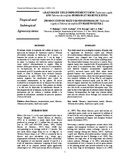| dc.contributor.author | Rutunga, V | |
| dc.contributor.author | Gachene, C K K | |
| dc.contributor.author | Karanja, N K | |
| dc.contributor.author | Palm, C A | |
| dc.date.accessioned | 2013-05-29T07:23:15Z | |
| dc.date.available | 2013-05-29T07:23:15Z | |
| dc.date.issued | 2003 | |
| dc.identifier.citation | Tropical and Subtropical Agroecosystems, 2 (2003): 1-11 | en |
| dc.identifier.uri | http://hdl.handle.net/11295/26798 | |
| dc.description | Journal article | en |
| dc.description.abstract | This study aimed at assessing the response of maize crop
to application of Tephrosia vogelii and Tithonia
diversifolia biomass obtained six month-old fallows. The
biomass were chopped into 5-cm long pieces and
incorporated in the soil one week before planting maize.
The natural fallow biomass was used as a control. These
organic inputs were supplied with 20 kg phosphorus (P)
/ha to attain P recommended rates. Shrub aboveground
and litterfall biomass incorporation significantly
(p=0.05) increased maize yield. Plots where above
ground biomass was removed produced lower maize
yield compared to those where the aboveground biomass
was retained. Addition of 20 kg P/ha to soil together
with the biomass increased maize yield by 40%. P in
form of organic materials was insufficient to meet plant
nutritional requirement. Residual effect of the biomass
was low on the second and third subsequent crops. This
may be due to the high rate of nutrient release during the
biomass decomposition, the high crop nutrient uptake
and also the nutrient losses through soil chemical and
physical processes | en |
| dc.language.iso | en | en |
| dc.subject | Biomass | en |
| dc.subject | Improvement | en |
| dc.subject | Maize | en |
| dc.subject | Maseno | en |
| dc.subject | Tithonia diversifolia | en |
| dc.subject | Tephrosia vogelii | en |
| dc.subject | yield | en |
| dc.title | Grain maize yield improvement using Tephrosia vogelii and Tithonia diversifolia biomass at Maseno, Kenya | en |
| dc.type | Article | en |
| local.publisher | Department of soil science, University of Nairobi | en |

